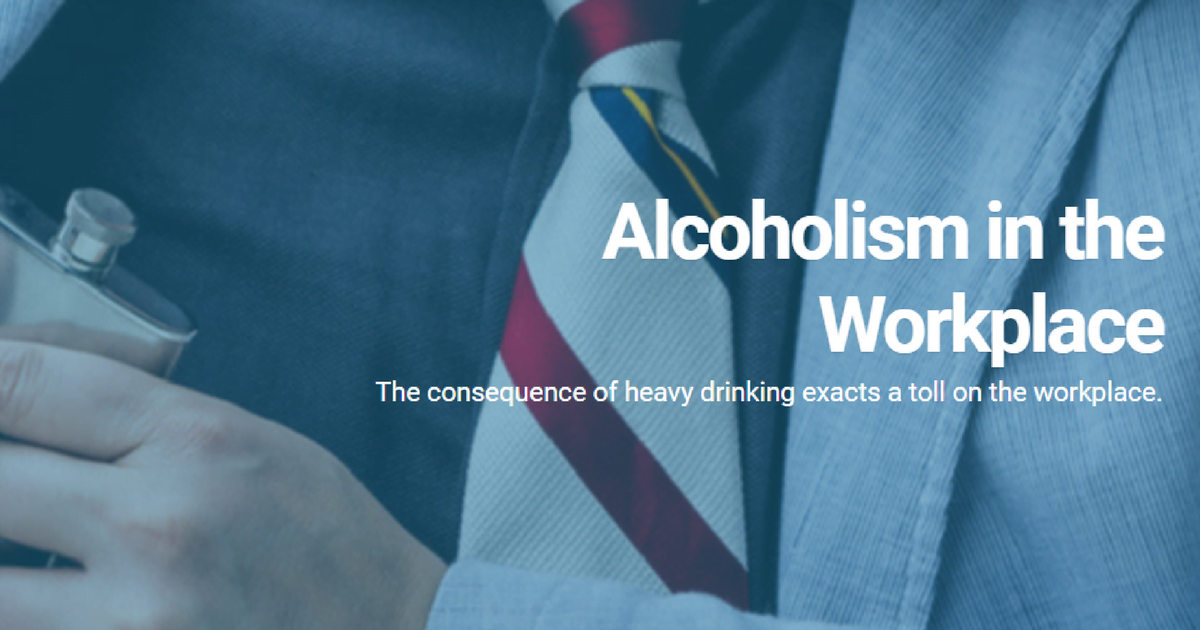

Alcoholism in the Workplace
The consequence of heavy drinking exacts a toll on the workplace.
Alcohol is the most widely abused drug in the United States. The National Institute on Alcohol Abuse and Alcoholism has reported that about 14 million adults in this country, equating to 1 in 13, currently abuse Alcohol or are an Alcoholic. On top of that, many others engage in behaviors that could lead to their Alcohol consumption becoming problematic. It can be challenging to recognize the line between a social drinker and one who needs help for Alcoholism.
Economic Cost of Alcohol Abuse
The cost of alcoholism is excruciatingly high, and the cost can include health care costs, the loss of productivity, traffic accidents and personal tragedies. There have been various studies on the costs of alcoholism, with estimates of the cost to the workplace, in particular, being between $33 billion and $68 billion. Alcoholism affects every level of society and is often a contributing factor in injuries, at work, on the road, or in the home. In fact, 50% of all traffic fatalities involve alcohol.
Effects of Alcohol Abuse on the Workplace
Looking specifically at the workplace, the cost of alcoholism is seen in a variety of ways. Alcoholics and alcohol abusers are between four and eight times more likely to be absent from work. Those who have a family member who is an alcoholic have a greater rate of staying away from work or school without good reason. Furthermore, alcoholics are far more likely to sustain injuries at work.
There are certain industries in which alcoholism is more prevalent than in others. People who work in more dangerous jobs are more likely to have higher levels of drinking. Occupations that tend to have a prevalence of alcoholism include:
- Bartenders, who are 2.33 times more likely to have a death that is related to alcohol compared to other jobs
- Shoe machine operators, where the risk is twice as high
- Roofers, where the risk is 1.87 times as high
- Painters, where the risk is 1.85 times as high
- Cooks, where the risk is 1.77 times as high
- Sailors, where the risk is 1.75 times as high
- Construction workers, where the risk is 1.72 times as high
The drilling and mining industry also have higher incidences of alcoholism, as does the excavation industry, the food service industry, and industries that install, repair and maintain equipment.
According to the National Council on Alcoholism and Drug Dependence:
- Employees with an alcohol problem are three times more likely of being absent due to injuries.
- Around 25% of employees have reported having had an alcoholic drink during working times at least once in the past year.
- About 20% of employees and managers felt that their safety or productivity at work was jeopardized by the drinking behavior of a co-worker.
- Around 35% of those admitted to the emergency department following a workplace injury had risky alcohol consumption.
- Employees who abuse alcohol pose complex issues for coworkers, managers, businesses, and themselves.
Dealing with an Alcoholic Employee
If you supervise people at work, then you must learn how to deal with alcohol abuse in the workplace. You will be responsible for the overall team’s productivity and behavior. While you should not diagnose alcoholism, you should be able to recognize the certain unusual behavior. Your responsibility is to review and appraise performance, set schedules, take disciplinary or corrective action where needed and refer your staff to the Employee Assistance Program if need be, as each of these issues can be affected by alcoholism. If your employee is showing signs of alcoholism, give us a call. We can help you figure out what options would be best for the suffering individual: (866) 578-7471.
In 2014, 24.7 percent of adults admitted to binge drinking in the past month.
Employer’s Responsibilities for Alcoholism in the Workplace
Your role is absolutely vital. You must remember that you are not there to diagnose alcoholism. You are there to ensure that these employees are held accountable for their actions and get them the help that they need. Telling alcoholics that their job is on the line if they do not improve their performance and behavior, and get help can be a very effective way for them to actually make the necessary changes.
Since the EAP concept was created by the NCADD, towards the end of the 1940’s, millions of people have been able to get help with alcoholism or alcohol abuse. By having an EAP in place, alcohol abuse and issues with other substance abuse can be effectively managed and improved. The cumulative effect of this is that families also start to improve.
When a support system is firmly in place, an employer can help reduce the negative impact of alcohol abuse on the workplace. They can also make sure employees become more likely to live a life of sobriety. Evidence has demonstrated that treating someone with an alcohol use disorder is also very cost effective, as productivity is increased and employee turnover and healthcare costs are reduced.
How to Deal with an Alcoholic Coworker
What if you are not the manager of an alcoholic, but rather a co-worker? Deciding how to manage this can be incredibly difficult. The question of whether or not to report to management is impossible to answer, not in the least in hierarchical workplaces where going to the manager is considered as being disloyal. That there is a need to take action is usually quite clear, but whether someone actually does it tends to depend on whether the alcoholic’s behavior places other workers in danger. Coworkers do not have a responsibility to diagnose alcoholism. They are contractually and legally obliged to report about safety concerns that they may have.
It can be very difficult to help coworkers with an alcohol problem. This is true not in the least because they are often in denial; they can become angry and defensive if people tell them they are worried about their alcohol problem. However, ignoring it for fear of confrontation will only make things worse. Confrontation is often what is needed, but this should be done in a way that is non-accusatory and non-judgmental. It should be about facts and it should include practical help that is available. If you need help on how to confront your coworker, and want to get them the treatment they need, give us a call: (866) 578-7471.
Alcohol misuse contributes to over 200 illnesses and injury-related health disparities.
Identifying Alcohol Abuse in the Workplace
It’s true that you are not responsible for a diagnosis of alcoholism. However, there are some signs and symptoms to be aware of, that could point to an alcohol problem being present, which in turn could warrant a referral to your EAP. Signs and symptoms of an alcoholic don’t always occur when they are actively drinking or drunk. Many signs and symptoms come from withdrawing from Alcohol, which can be quite serious and scary.
Some of the things to look out for include:
1. Poor attendance and frequent leaves, including:
- Frequent tardiness.
- Unauthorized or unexplained absences
- Frequent filing of sick leave
- Having patterns of absence, including the same day every week or even every month.
- Having frequent “emergencies”, rendering it difficult or impossible to come to work, such as family emergencies or car troubles.
- Not being at the workstation without permission or explanation for long periods of time.
2. Poor performance, including:
- Making mistakes
- Frequently missing deadlines
- Returning sloppy or careless work, or not completing assignments
- Not meeting production quotas
- Making various excuses for performance problems
Performance problems can be hidden for a long period of time, particularly if the job is a long term project.
3. Poor work relationships, including:
- Having strained relationships with team mates
- Being short tempered, argumentative, or belligerent – seeing patterns in this behavior as well
- Not building any relationships at work
- Noticeable financial difficulties – for instance, asking coworkers for loans, or receiving communication at work from debt collectors.
4. Poor work behavior, including:
- Appearing drunk at work
- Smelling of alcohol, including breath
- Having an unsteady, staggering gait
- Bloodshot eyes
- Changes in behavior and mood, including speaking too loudly and bursting out laughing
- Avoiding managers, particularly after breaks
- Sleeping on the job
- Tremors
Remember that none of the symptoms mentioned above definitely means that the employee is an alcoholic. However, if several of these signs are present, a manager may have grounds to refer the employee to the EAP. They are then able to assess the situation and, if appropriate, diagnose alcoholism.
Over 16 million adults are diagnosed with an Alcohol Use Disorder within a single year.
Staging a Workplace Intervention
Interventions are a popular technique utilized in the workplace to confront an employee who is suspected of being an alcoholic. It is vital that this is done properly; this means scheduling and organizing a session in which the employee is present, as well as others who have a significance at work and outside of work. This includes the manager, the spouse, clergy, friends, and direct coworkers. It is very important to have a trained professional present, which the EAP can organize for you. During the intervention, each person in attendance will discuss how the behavior has affected them.
The session must be led by a trained professional, such as the EAP counselor. It involves having each of the individuals present directly tell the employee how his or her drinking has affected their lives and what the consequences of that employee’s drinking have been. If the intervention is effective, it can bring about some significant changes. If it is not done properly, it can backfire tremendously, leading to the individual withdrawing even more. This is why it is so important for a manager to first speak to the EAP for advice and ask them to provide the services of an interventionist.
Coworker interventions are a little bit different. The entire team gets together to confront their coworker who is suspected of abusing alcohol, particular with regards to how his/her behavior is affecting them. This can be a powerful tool, particularly if the people concerned stand to lose their job as a result of their problem, or if others are no longer able to perform their job. It is possible to organize this with a trained interventionist as well. Coworker interventions are generally more effective than individual interventions. During the meeting, the concerned workers will be given evidence as to how their behavior has been poor, and they will then be given a choice: seek help or find other work. This can be the “rock bottom” that many people speak off, prompting them to seek the help they need.
Important Features of an Intervention:
- A group of people join together, discussing their worries with the addicted individual.
- Only concerns and facts should be reported on. It should be 100% non-accusatory and non-judgmental.
- The person should gain an understanding of the fact that co-workers are showing concern, and therefore actually care for him/her.
- Three to four solutions should be presented after everybody has spoken. The goal is to make sure that “seeking treatment” is at least one of those options.
- If managers are present, they should discuss consequences should the coworker be unwilling to commit to change.
- The discussions tend to end more positively if an interventionist is present.
Interventions in the workplace are always most effective if they have been properly planned and organized. While people may want to do something on the spur of the moment, because they are worried and genuinely care, this is generally not recommended. Going about it in a disorganized way often backfires. The exception is if the behavior of the alcoholic starts to pose a danger to other team members, or even to clients. In that case, an immediate confrontation is required.
To be more successful at an intervention, it is best for everybody who will attend to get together first and write statements that the others read and make changes to if need be. After this, the manager should organize the intervention itself, while also scheduling the discussion so that everybody has a chance to say what needs to be said and make their concerns known. Before the intervention, the team should also work together in order to make sure they know which consequences to impose should the alcoholic refuse treatment, as well as listing the available treatment options. This also shows unity from the team.
It is incredibly difficult to confront someone at work if you suspect they have an alcohol problem. However, ignoring the situation is much worse and the costs associated with simply hoping the problem will go away are much greater. With the help of a professional from the EAP, who can provide advice, information, and guidance, help in finding a treatment facility, and the services of an interventionist, it is possible to resolve the issue to the benefit of everybody involved. By calling (866) 578-7471 you can determine the options your co-worker has to proceed with their rehabilitation.








